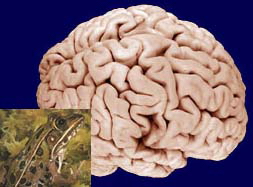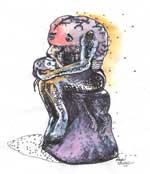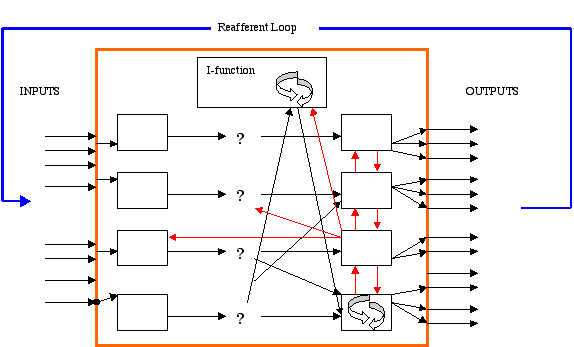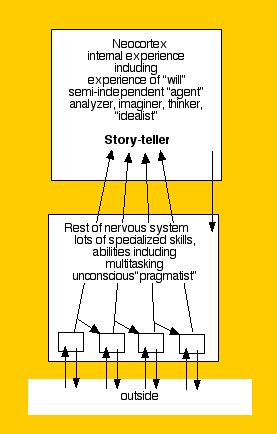Serendip is an independent site partnering with faculty at multiple colleges and universities around the world. Happy exploring!
Brain Behavior Institute - Session 11
|
|

|
BRAIN AND BEHAVIOR INSTITUTE 2008 |

|
Output Architecture, Continued
Reflecting on our own activities, our own laboratory in education
"Although I was intially uncomfortable with the fact that Paul makes up his own words to call things (!), cables, boxes, stories, I function, central pattern generator) , I have come to see that it is a really useful way to explain concepts to us/students. However, if I am having a conversation with someone who does not use this vocabulary, it would be really handy if I knew what word he/she was using to refer to the same process/structure ... I'd like to hear, as we go along, how "normal" people refer to some of these things!"
"I also sometimes feel the impatience of wanting to move faster. During these times I find myself riffing off what Paul is saying either by searching for stuff that is related on the interent or by jotting down my thoughts. It reinforces for me the idea that any group of people is made of so many different types of learners, with so many different types of agendas, level of previous background and interest in the material. I love the online form for this purpose. It allows us to make our points, explore what interests us and engage other people in meaningful diversions that don't slow down the pace of the overalll class. It also allows us to ask our own sets of questions."
"I realized that sometimes I need the discussion to clarify and deepen my undestanding of the concepts being presented. The difficulty, then, is to determine which principles need more time and which can we move through faster. Further, is there a way to determine if all those in the class feel the same way about the same principles."
I didn't particularly think about developing lesson plans or learning additional computer tools, and wouldn't necessarily have thought I wanted that. As it turns out, it has been useful and interesting for me to spend time developing these skills/lessons ... I ultimately came to view the afternoons ... as good opportunities to do some work that I wanted to do anyway, on developing new ideas for teaching about the brain, so the afternoons ... turned into good focused study/work sessions for me"
"I am seeing people in my family a little differently from what I saw before."
"Brain & Behavoir has given me a different perspective on how I look at these students."
"I would like to hear more about how to apply this information we are learning to the classroom… teaching strategies, methods, application…"
Student and teacher priorities
"I think in terms of helping people be comfortable with the computer, perhaps the 'teaching fellows' could be introduced as, and function more as, teachers/helpers in that regard."
Review (and completion of output side)

- Central pattern generation, corollary discharge
- Gene/environment interaction
- Motor influences on perception
- Distributed control - multiple interacting boxes, lots of loops (motor to sensory as well as sensory to motor)
Compliance is perhaps a poor choice of words ... Pro-social behavior may be more appropriate ... Grace I love jazz music but want a beautiful symphony in my classroom. My opinion is that there is a way to conduct it ... Joyce Emergent Pedagogy: learning to enjoy the uncontrollable - and make it productive
Finishing up a look from the output side
Where is "drive", "choice", "will"? The I-function?
- Randomness and exploration (see also Inverting the Relationship Between Randomness and Meaning)
- Multiple negative feedback loops (choices being made all the time without our being aware of it)
- Purposive, adaptive exploration and action can occur without the "I-function"
- The cognitive unconscious as a distributed system
- I-function as suppressor of existing possibilities, creator of new ones?
- The brain(=nervous system as a distributed system, no one in charge?
What particular aspect of our discussions of the motor side of the nervous system seem most useful for your classroom, for your teaching in general? Write some thoughts/questions in the forum area.



Comments
The relationship between teaching and being professional
Just to reiterate something mentioned but (at least from my knowledge) never recorded on serendip.
In principle professionals should be able to comfortably alternate between professional concepts and lay/comfortable terms that is accessible to the maximum amount of people. But in practice that is not true, one reason being because they are working with other professionals having all of the jargon be common language, allowing the esoteric behavior to speed up communication.
One way to distinguish between being skilled and being talented in that skill would be in the persons ability to put their information in laymen terms. If you can do that successfully then, I feel, that shows a sign of mastery and in that sense all teachers should be masters.
Phantom pain, reflexes, and LeChatelier
Friday's discussion on phantom pain led nicely into the discussion of reflex action, which, in turn, brought to mind the chemical principle that so many students "just can't" seem to fully internalize: LeChatelier's Principle. But more on that shortly.
The nervous system was described as constantly comparing actions with expectations. Mismatches produce dissonances: discomfort, pain or nausea.
So, the description of phantom pain as a "dissonance" between a motor action and a sensory response that doesn't match makes a lot of sense . . . and may answer a question I've held that has gone unanswered for a long time.
This same idea of the nervous system constantly making comparisons also explains how reflexes work. The same can seem to be said for nonsentient physical systems. Hence, . . .
LeChatelier postulated that all chemical systems at equilibrium when put under a stress will react so as to minimize the stress. For instance, if the temperature rises, the system moves in an endothermic manner so as to absorb the extra heat and lower the temperature. If an acid is added, the system tries to generate more base to neutralize the acid (minimize the pH change).
The reflex action was described in terms of a sensory nerve bundle that measures the length of a muscle. If the muscle lengthens, the nerves enervate to contract the muscle -- in order to maintain the original length -- or "minimize the change" like LeChatelier's Principle.
So, our nervous sytems have evolved according to simple physical principles, which, to a degree, is a bit "unnerving" to realize.
Cognitive unconscious as "society of mind": implications?
A couple of thoughts this year that I want to remember (because of the new thinking of drives in terms of negative feedback loops in the cognitive unconscious) ...
"Choices are being made all the time without our thinking about it/being aware of it"
"I don't know what I know how to do (or not do) nor ofte what I want to do (or don't want to do) except by watching myself do things, or having others tell me what I'm doing."
What about repressed
Reflections Do we
Without the distractions am I now able to pull my I-function into play and actually formulate new ideas about the series of connections? I’m excited about the new theories that I can investigate in my classroom.
Reflection - I-Function
Taking it into the classroom
If we can put all we have learned so far about how the brain operates from one person to another with particular reference to it's randomness, individuality creativity etc and apply it to our classrooms, it is possible to come up with a positively productive and seemingly orderly outcome that will surpass our imagination compared to if we decide to stick with our former impression of compliance and relative order in our classrooms.
Putting this impression into perspective, the first issue I need to address is identify the qualities embedded in my students from the time they step into my classroom in September and see each of them as a contributor to what will be the outcome of the whole group socially, academically and emotionally at the end of the school year. I’m in effect looking at all (teachers and students) as contributors of various inputs which will culminate in a richer output compared to if all the input is expected to come from me as the teacher.
In conclusion, the first task that educators have at the beginning of the school year is to discover the qualities embedded in the students they are going to work with (not teach) for that particular year and take advantage of it rather than suppress it.
Best Practices
is to recognize and understand thine-own cognitive unconscious.
I was trying to apply these ideas to my own teaching practice as I listened to Paul’s explanation. In one way the reactive response of various students to the content that I may model in class could be just the cognitive unconscious plugging in at that moment. This may be an incorrect supposition, but I think initially the structure of new learning needs to be built in the lower ‘boxes’. There this framework will reside until such time that a newly woven meaningful structure can be built from the bones of cognitive unconscious by the I-function
I-Function and Readiness
Though it got a little complex for me but I was able to relate this concept to my 16 months old nephew who was born prematuredly at 5 months pregnancy. I believe I am interested in watching him do every little thing because I am conscious of the circumstances surrounding his birth. I guess I am wondering if everything is fine with him. As I watched him play with the ballon which he calls ball, this morning, I observed that when I threw the "ball" on the flooor, to the right or left, he picked it up or kicked it back to me. When I put it on my head he thought for a moment but did not do anything. When I put it on his head he stopped for a few seconds then reached up for the "ball" on his head.
I would have been concluding that he may be slow, but I'm rethinking that now. He probably was engaging his I-Function in the new skill of reaching for the ball on my head and on his head. The time he got it together was when he reached up for it.
This reminds me of the concept of late bloomers; and it ties very well with the classroom situations. Some students get it right away whereas some take a while. I am convinced teachers need a lot of patience to handle the gap.
Neocortex
Refelections on Brain and Behavior
good boxes
As for application to kids: when we see 'bad' behavior, I think we view it the same way; as the organism's/student's best attempt to survive in its system, even if it is a misguided and dysfunctional attempt.
It sounds like you are
Morning Session I- Function
The Stretch Reflex
Making sense of a medical
Making sense of a medical story. Parkinson's disease is a neurological illness caused by a decrease on levels of a neurotransmitter, dopamine, in the brain. Symptoms include stiffness, loss of muscle control. Ultimately resulting in behavior that appears to be a very extreme example of what was demonstrated this morning. Traditionally, the most potent treatment is sinemet a drug that increases levels of dopamine. It is able to prevent or ease the extent of the contractions or paralysis. I think...
Michael Jordan
PROJECTS
Post new comment